| Cabriole (KAB ree ole) leg The name given to chair or table legs in the style of the first half of the 18th century:Queen Anne – usually with pad foot,Chippendale – commonly with claw-and-ball footA curved leg with outcurved knee and incurved ankle. The foot may be a club, a claw-and-ball, a paw or scroll, and there may be a carved ornament on the knee such as the scallop shell or the lion motif. Originated in Italy and is a conventionalized representation of the rear leg of a leaping goat. Modeled after an animal’s leg, the S-shaped cabriole leg gives furniture a more intimate, human quality than the massive turned legs of the William and Mary style. The cabriole leg is also extremely practical; the balance it achieves makes it possible to support heavy pieces of case furniture on slim legs, without the use of stretchers.Used on many types of furniture besides chairs.Illustration: Bergere (shepherdess) chair – Hofmobileliendepot Imperial Furniture Collection,Vienna, AustriaChair with trifid foot – Fairmount Park Woodford House, Philadelphia Chair – Theodore Roosevelt Inaugural Site Chair – William and Mary wing armchair – Edward Harvey House. 91 Jewett Parkway Chair – C. 1730 English Side chair Chair – Queen Anne side chair – Independence Hall, Philadelphia Dressing table – C. 1740 Queen Anne lowboy dressing table Breakfast table – Amherst Humphrey Houseat theGenesee Country Village, & Museum Federal candlestand – American Antique Furniture, Orchard Park, NYHighboy – Queen Anne – Lang Collection | |
 | Knee The upper convex curve of a cabriole legIllustration: Chippendale lowboy – Fairmount Park Woodford House, Philadelphia C. 1730 English Side Chair Queen Anne armchair – from the Georgia Forman HouseChippendale armchair – McCann House |
| Lyre-shaped legs Popular during the Empire period. | |
 | Marlborough leg A straight, sometimes fluted leg with a block as a foot that was used in the mid-18th-century English and American furniture.Block foot: Another name for the Marlborough foot It was especially favored by Chippendale.Illustration: Reproduction Chippendale English tea table – Kittinger Furniture Company |
 | Spider legsIllustration: American Antique Furniture, Orchard Park, NY |
| Spiral leg A leg resembling a twisted rope, or a support with a winding descending flute or groove. It was originally of Portuguese and Indian origin, and became popular during the Restoration.Illustration: Empire card table– Private collection, Buffalo, NY | |
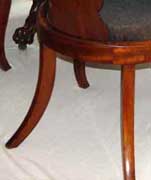 | Saber legs Chair legs tapered to resemble a cavalry saber. First used on the Greek klismos chair. Both the Greeks and Romans used saber and animal legs. Fine splayed legs often found on early 19th century Sheraton chairs in the Grecian manner. The front legs flare forward, the rear legs curve out behind.Illustration: Empire style side chair in klismos shape – Livingston- Backus House, Genesee Country Village, & Museum Klismos chair on Greek vase –Museum of Fine Arts, Boston Fiddleback chair – American Antique Furniture, Orchard Park, NYFor more examples, see American Empire – Chairs |
 | Square leg Hepplewhite Pembroke table – American Antique Furniture, Orchard Park, NY |
 | Tapered leg Leg narrows from top to bottom. Found on Hepplewhite pieces. A raised, tapered design superimposed on the existing leg is referred to as the “spade” foot. Illustration: Hepplewhite Pembroke table – American Antique Furniture, Orchard Park, NY |
| Arrow foot A cylinder-shaped foot that is tapered and separated from the leg by a turned ring. Commonly found in Hepplewhite and Sheraton designsIllustration: Sheraton style card table – Kittinger Furniture Company Cane-seated side chair – Athenaeum, Philadelphia Dressing table – Colonial Revival and Hoosier FurnitureDining room table – Lang Collection | |
 | Ball foot Turned round foot.Similar to a bun foot, but rounder. Most popular in the William and Mary period; also used on some Empire piecesIllustration: Kas – Private collectionWindsor chair – Fairmount Park Woodford House, Philadelphia Five William and Mary style ball feet Sheraton side chairs – MacKay Homestead, Genesee Country Village, & Museum French or Flemish Renaissance Chair – Memorial Art Gallery of the University of Rochester William and Mary highboy – Winterthur MuseumSideboard – Lang CollectionChina cabinet – Lang Collection |
 | Block foot See Marlborough leg above |
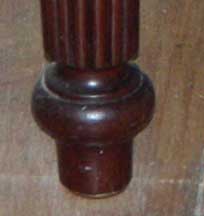 | Blunt arrow footIllustration: Sideboard – MacKay Homestead, Genesee Country Village, & Museum Sheraton square-back sofa |
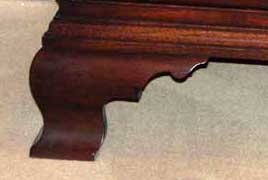 | Bracket foot Also called a console leg.One of the simplest of furniture feet shaped like a bracket, usually with a mitered corner. Variations include a plain bracket foot, a molded bracket foot, or a scrolled bracket foot.See French foot belowCommonly found in Hepplewhite and Sheraton designsIllustration: Scrolled bracket, reproduction Chippendale chest on chest – Kittinger Furniture CompanyScrolled bracket, secretary – George Wythe House, Williamsburg, Va. Ogee bracket, George III Secretary – Dana Tillou Fine Arts Plain bracket, Victorian enclosed-front bookcase – Old Editions Book Shop and Café Grandfather clock – Lang Collection Chest-of-drawers – Lang Collection |
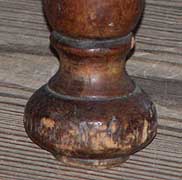 | Bun foot A squat version of a ball foot, flattened slightly on top and more at the bottom.Illustration: William and Mary slat-back armchair – Independence Hall , Philadelphia, Pa Corner chair: Fairmount Park Woodford House, Philadelphia Victorian davenport – Private collection, Orchard Park, NY |
| Claw-and-ball footCarved to represent a bird’s claw grasping a ball Derived from the Chinese dragon’s claw holding a crystal ball or jewel.Perhaps first adapted in Europe by the Dutch, it spread to England, from whence it was introduced to America about 1735. Enormously popular as the foot of American cabriole leg furniture in the Queen Anne and Chippendale, styles. In America, a bird’s claw was generally used, mostly the eagle’s.Also used in the twentieth century in the Colonial Revival cabriole leg.Illustration: Ansley Wilcox Mansion / Theodore Roosevelt Inaugural SiteChippendale carved mahogany tea table – Dewitt Wallace Decorative Arts Museum, Williamsburg, Va.Chippendale lowboy – Fairmount Park Woodford House, Philadelphia Chippendale highboy – Kittinger Furniture Company | |
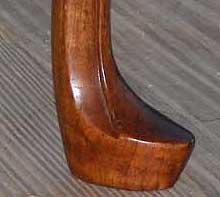 | Club foot / pad foot Foot with a slightly pointed toe, usually thick and substantial. Found especially in William and Mary, Queen Anne and Chippendale styles.Illustration: Queen Anne side chair –Independence Hall, Philadelphia |
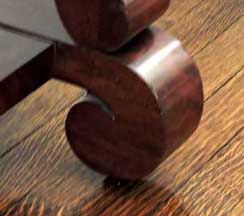 | C-scroll Found especially in Empire style Illustration: Hewlitt House / Inn Buffalo |
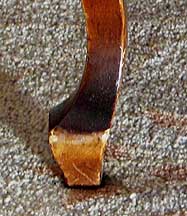 | Cuffed footIllustration: Combination sofa/settee – Colonial Revival and Hoosier Furniture |
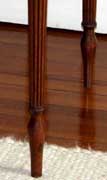 | Cylindrical feetIllustration: Sheraton worktable |
| Drake foot See “Trifid foot” | |
| Dutch foot See “pad foot” below | |
 | Elongated bulb feet Sometimes found on Sheraton style tables |
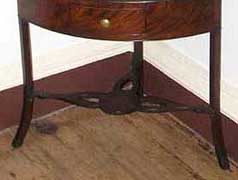 | Flared footIllustration: Federal washstand – Fairmount Park Woodford House, Philadelphia |
 | French (bracket) foot A simple outswept bracket foot. Has concave curve down the mitered edge which gives a splayed effect. Both the inner and outer edges of the leg are curved, giving the appearance of a stunted cabriole leg, or, as some would say, a light , graceful; appearance. Almost always found on case furniture in combination with a valanced skirt or apron. Popular in 18th-century English and American furniture, including Hepplewhite and Sheraton designsA Lady’s Secretary,Plate 43,The Cabinet Maker’s and Upholsterer’s Drawing Book, by Thomas Sheraton – Fairmount Park Woodford House, Philadelphia Furniture: Furniture: George III bow front bookcase and chest – Dana Tillou Fine Arts English Sheraton sideboard – Private collection, Orchard Park, NY |
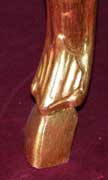 | Hoof footIllustration: Rococo upholstered chair – Hofmobileliendepot Imperial Furniture Collection,Vienna, Austria |
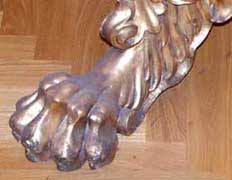 | Lion’s paw footIllustration: : Hofmobileliendepot Imperial Furniture Collection,Vienna, Austria |
 | Marlborough foot See Marlborough legabove |
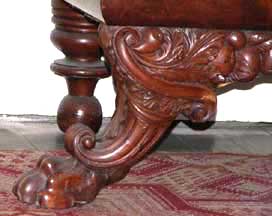 | Monopodium Animal foot and the extension from it, often in the form of a wing or a cornucopia, found on Empire furnitureIllustration: Empire Sofa: Athenaeum, Philadelphia Sofa – Memorial Art Gallery of the University of of Rochester Empire sofa – McCann House |
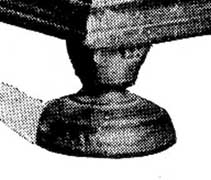 | Onion footAn onion-shaped turned foot of the Early Renaissance not very much used after the William and Mary Period.Illustration: William and Mary style – Luke Vincent Lockwood, Colonial Furniture in America, 1926 |
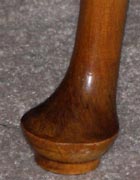 | Pad footAlternate names: Dutch foot, club foot A flattened disk-like foot often found under a cabriole leg. It is similar to a club foot.Sometimes a club foot resting on a disk is termed pad foot. Favored on Queen Anne cabriole legsIllustration: Queen Anne highboy – Dana Tillou Fine ArtsReproduction Queen Anne tea table – Kittinger Furniture Company, Inc.C. 1740 Queen Anne Lowboy Dressing Table – Dewitt Wallace Decorative Arts Museum Queen Anne table – Fairmount Park Woodford House, Philadelphia Queen Anne – Private collection, Buffalo, NY |
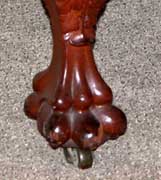 | Paw foot A foot carved to resemble an animal’s paw, most frequently that of a lion. Above it there is generally carved leafage.”Greek tripod tables (usually used for serving wine) had legs carved into animal leg and paw foot designs modified from ancient Egyptian prototypes with the introduction of duck heads and acanthus leaves.”- Treena Crochet, Designer’s Guide to Furniture Styles,” pub. 2204, p. 47Illustration: Theodore Roosevelt Inaugural Site Reproduction Duncan Phyfe dining table – Edward Harvey House. 91 Jewett Parkway Reproduction Federal dining table – Kittinger Furniture Company Neoclassical clock – Residence Museum, Munich, Germany Empire bookcase – Old Editions Book Shop and Café |
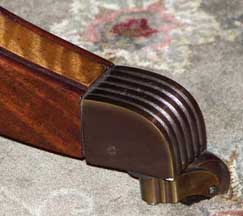 | Reeded brass footIllustration: Custom dining table – Kittinger Furniture Co. Often on a caster |
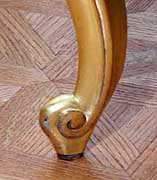 | Scroll foot / Scrolled toe / Whorl foot See Whorl foot below See C-scroll foot above |
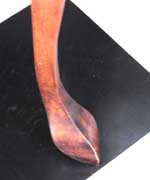 | Slipper foot A club foot with a more pointed and protruding toe. Popular in Queen Anne period. Illustration: Lang Collection |
 | Snake footFoot carved to look like snake’s head.Narrow elongated foot swelling slightly upward before pointed end. Found in 18th century English and American furniture, e.g., Queen Anne , Chippendale and some Federal tripod-base tablesIllustration: Chippendale Federal tilt-top piecrust table –Dana Tillou Fine ArtsQueen Anne pedestal table – Fairmount Park Woodford House, Philadelphia Wig stand – Fairmount Park Woodford House, Philadelphia Queen Anne table – from the Georgia Forman House Federal candlestand – American Antique Furniture, Orchard Park, NY |
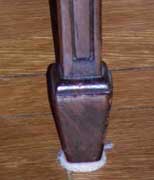 | Spade footTapered rectangular footPopularized by Thomas Chippendale.Commonly found in Hepplewhite and Sheraton designs.Formed by applying pieces of wood – not by carving.Illustration: Shield-back armchair – Edward Harvey House. 91 Jewett ParkwayFurniture: Reproduction Hepplewhite side chair – Kittinger Furniture Co.Federal Gentleman’s Secretary-and-Bookcase – Derived from plate 52 of Thomas Sheraton’s The Cabinet-Maker and Upholsterer’s Drawing Book (London, 1793) English Sheraton sideboard – Private collection, Orchard Park, NY |
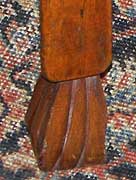 | Spanish footAlso called: Spanish scroll foot or Braganza toe Scrolled foot with curving vertical ribsA hoof-like, grooved and flared foot which ends in an inward curving scrollIntroduced from Portugal during the Restoration period and used in 18th-century English and American furniture, especially on turned legs in the William and Mary and the Queen Anne periodsWilliam and Mary corner chair: Fairmount Park Woodford House, Philadelphia William and Mary table – George Wythe House, Williamsburg, Va. Chair – Old Editions Book Shop and Café William and Mary armchair – Dewitt Wallace Decorative Arts Museum Piano bench – River Lea Portuguese Baroque Leather Chair –Memorial Art Gallery of the University of Rochester |
 | Splay foot Same as flared foot above. |
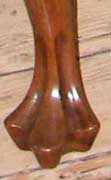 | Trifid (TRY fid) foot Alternative name: drake foot3-lobed endpiece of a Queen Anne cabriole leg.Derived from Irish furniture design.Illustration: Fairmount Park Woodford House, Philadelphia Queen Anne armchair – from the Georgia Forman HouseQueen Anne lowboy/dressing table –Fairmount Park Woodford House, Philadelphia Queen Anne highboy – Winterthur Museum Queen Anne side chair – Winterthur Museum |
| Turnip foot A ball foot with a small collar at the base | |
 | Whorl foot / scrolled toe / scroll foot A reverse scroll foot An up-curved, carved foot done in scroll motif, terminating a cabriole leg. A flattened scroll at the end of a cabriole leg originated in the Louis XIV (Baroque) period Used on Louis XV (Rococo) substyle pieces.Many of the drawings in Thomas Chippendale’s Gentleman and Cabinet Maker’s Director in 1754 feature whorl feet. Appears in England in the William and Mary and Chippendale periods.Illustration: Gilded Rococo armchair – Palace at Versailles, France French style (reverse scroll feet) Rococo sofa – Plate XXXI, Gentleman and Cabinet-Makerís Director C. 1885 French Rococo armchair – 94 Oakland Place Steinway piano – River Lea Circa 1900 French Art Nouveau cabinet – 143 Linwood Avenue |
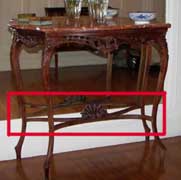 | StretcherThe crosspiece that connects, braces, and strengthens the legs of tables, chairs, chests, etc. Turned rod, or plain or cutout slat, used to reinforce legs.Egyptian craftsworkers reinforced the joinery by adding stretchers, continuous stretchers, or runners to the legs of stools and chairs. Occasionally, struts were also added between the stretcher and seat rail for extra stability and strength.Illustration: 19th century marble Italian table – Horace Reed House William & Mary slat-back chair – Independence Hall, Philadelphia Wing armchair – Fairmount Park Woodford House, PhiladelphiaKittinger Colonial Revival/Jacobean Revival style armchair – McCann House |
 | Box stretcher A structural configuration on the base of a chair that has a bar from leg to leg.Illustration: William and Mary highboy – Winterthur Museum Lang Collection |
| Cross stretcher See X-stretcher below | |
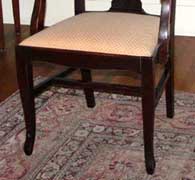 | H stretcher A reinforcing element for chair, table, and case furniture legs. A wooden piece, or turning, connects each front leg with the leg immediately behind it. A crosspiece from one of these connecting pieces o the other forms an H.Illustration: Theodore Roosevelt Inaugural Site William and Mary wing armchair – Edward Harvey House. 91 Jewett ParkwayWindsor chair – Independence Hall, Philadelphia Hepplewhite style chair – Fairmount Park Woodford House, Philadelphia C. 1820 English game table – Horace Reed House English desk-on-frame – Horace Reed House |
 | X stretcher Alsocalled cross stretcher orsaltierCross stretchers made flat or curved upward in serpentine form, with knobs or other ornamentation at the intersection. Used to connect the four supports of a chair or piece of furniture, and to reinforce them.Domed cross stretcherIllustration: 19th century marble Italian table – Horace Reed HouseBaroque writing table – Hofmobileliendepot Imperial Furniture Collection,Vienna, Austria Domed stretcher: Reproduction Chippendale English tea table – Kittinger Furniture Company William and Mary dressing table – Winterthur Museum |

